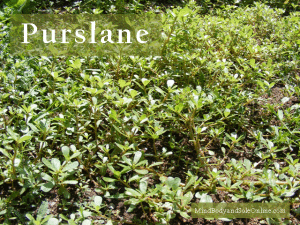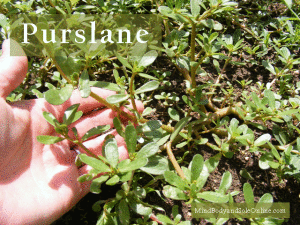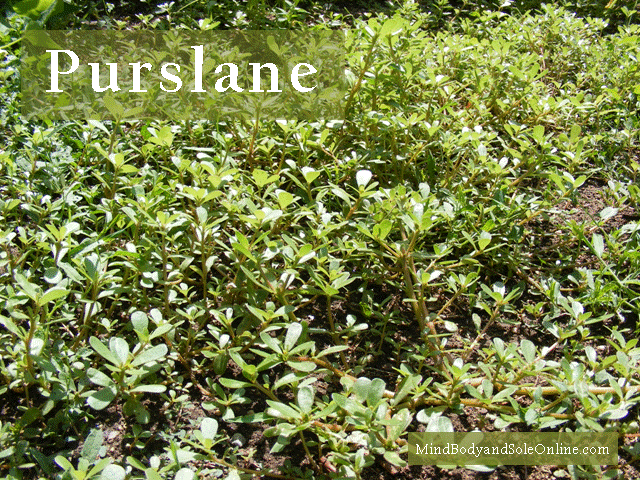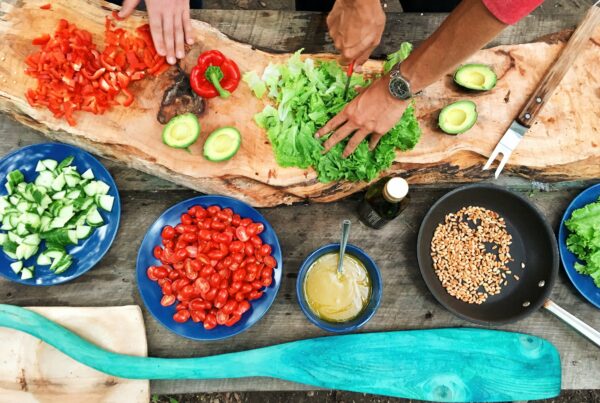The following information is provided compliments of The Weston A. Price Foundation. Weston A. Price Foundation is a nonprofit, tax-exempt nutrition education foundation. Read our mission statement. . . Become a member and receive our lively and informative quarterly journal. Click here for a message from Sally Fallon Morell. Read our Dietary Guidelines here.
The article is written by Rosemary Barron and appeared in Wise Traditions in Food, Farming and the Healing Arts, the quarterly magazine of the Weston A. Price Foundation, Summer 2000.
Purslane
 Although purslane is rarely seen on our own tables today, this pretty herb has a long and interesting history. English medieval cooks and gardeners loved purslane. The ancient Greeks made a bread flour from purslane seeds and pickled its fleshy stems; Greek country cooks now serve purslane as a salad herb, either alone or with other khorta (wild greens). On Mexican tables, the hot, peppery bite of cooked purslane is enjoyed with eggs and pork, while Chinese cooks value its sharp flavor and slightly slippery quality with noodles.
Although purslane is rarely seen on our own tables today, this pretty herb has a long and interesting history. English medieval cooks and gardeners loved purslane. The ancient Greeks made a bread flour from purslane seeds and pickled its fleshy stems; Greek country cooks now serve purslane as a salad herb, either alone or with other khorta (wild greens). On Mexican tables, the hot, peppery bite of cooked purslane is enjoyed with eggs and pork, while Chinese cooks value its sharp flavor and slightly slippery quality with noodles.
Closer to home, the FDA lists purslane as a pervasive weed (the 7th worst, worldwide) but to those of us who love its earthy, slightly acidic flavor and crisp, succulent stems and leaves, the word ‘weed’ hardly seems fair. Purslane is simple to grow and there are several varieties available to the gardener – the two best culinary ones are both summer herbs, portulaca oleracea (green purslane) and portulaca sativa (golden purslane).
Medieval herbals describe purslane as ‘cold,’ meaning that it was considered a cure for a ‘burning’ (or malfunctioning) heart and liver. Greeks call it a ‘blood-cleansing’ herb. In Mexico, purslane is considered good for diabetics. Recent research has confirmed that purslane is one of the best vegetable sources of omega-3 fatty acids, as well as carotenes and vitamin C.
 Purslane is one of my own favorite green vegetables. Clusters of its young, fresh leaves are a perfect foil to ‘sweet’ vegetables such as new potatoes, beets, fava beans and garbanzo beans, and juicy vegetables such as cucumber and tomatoes. Or, simply sprinkle the leaves generously with coarse sea salt, lemon juice and olive oil and serve with fish, grills, or omelets. My neighbor on Crete used to add handfuls of purslane sprigs to the juices in the roasting pan, once he had removed the roast for carving. After a few minutes of swishing, the greens would wilt and the sauce would acquire a sharper flavor and pleasantly gelatinous character.
Purslane is one of my own favorite green vegetables. Clusters of its young, fresh leaves are a perfect foil to ‘sweet’ vegetables such as new potatoes, beets, fava beans and garbanzo beans, and juicy vegetables such as cucumber and tomatoes. Or, simply sprinkle the leaves generously with coarse sea salt, lemon juice and olive oil and serve with fish, grills, or omelets. My neighbor on Crete used to add handfuls of purslane sprigs to the juices in the roasting pan, once he had removed the roast for carving. After a few minutes of swishing, the greens would wilt and the sauce would acquire a sharper flavor and pleasantly gelatinous character.
At home, you will often find purslane growing in muddy fields; or search for it in Greek, Middle Eastern, Mexican and Chinese markets. It is very easy to grow. Purslane seeds may be ordered from The Cook’s Garden catalog (800) 457-9703. To prepare purslane for the table, be sure to rinse it well in several changes of cold water.
Purslane Salad
(Serves 4)
- 4 cups purslane sprigs or 1 cup purslane sprigs and 3 cups arugula, escarole, romaine, chicory frisée and/or young spinach leaves
- 2 scallions, trimmed, the best green parts left intact, and thinly sliced (optional)
- Coarse sea salt and cracked pepper to taste
- Strained juice of 1 small lemon, or to taste
- 5 tablespoons extra virgin olive oil, or to taste
Thoroughly rinse the purslane and remove the small fleshy leaves in clusters (the stems are easily broken with your finger and thumbnail). Rinse the salad greens and pat dry; tear into bite-size pieces. Combine the greens and scallions in a salad bowl and sprinkle with salt and pepper, lemon juice, and olive oil. Toss with a wooden spoon and fork and salt add salt, pepper and/or lemon juice to taste. Serve immediately.
Purslane and Young Beets
(Serves 4)
- 3 medium young beets, baked in a clay pot or boiled, and peeled
- Large pinch of ground cloves
- Coarse sea salt and cracked black pepper to taste
- Strained juice of 1 large lemon
- 1/3 cup extra virgin olive oil, or to taste
- 3 cups purslane sprigs
- 2 scallions, white parts only, thinly sliced
Cut the beets into a julienne (large matchsticks). Place in a non-reactive bowl, sprinkle with the cloves, salt and pepper, and half the lemon juice and olive oil. Gently toss together, taking care not to break the beets. Cover and set aside for 1 hour or refrigerate for up to 4 hours. Thoroughly rinse the purslane and remove the small fleshy leaves in clusters. Combine the beets, purslane and remaining lemon juice and olive oil in a salad bowl. Add salt and pepper to taste, sprinkle with the scallions and serve immediately.
Purslane and Feta Cheese
(Serves 4)
- 2 cups purslane sprigs, rinsed and patted dry
- 2 ripe tomatoes, peeled, seeded, and cut into a 1-inch dice
- 1 small hothouse (English) cucumber, peeled, and cut in small dice
- 4 scallions, including the best green parts, cut in thin slanting slivers
- 2 radishes, scrubbed and thinly sliced
- 1 cup coarsely chopped flat leaf parsley
- 1 tablespoon dried rigani (Greek oregano), crumbled between fingers and palm
- 1 tablespoon fresh lemon juice, or to taste
- 1/4 to 1/3 cup extra virgin olive oil, to taste
- Cracked black pepper to taste
- 12 Niçoise olives or 8 Kalamata olives, drained
- 1 cup drained feta cheese, in pieces
A few minutes before serving, combine the purslane, tomatoes, cucumber, scallions, radishes, parsley, and rigani in a serving bowl. Whisk together the lemon juice and olive oil, pour over the salad and sprinkle with the pepper and olives. Lightly toss everything together, then sprinkle with feta cheese. Serve with pita bread.
Purslane with Fish and Pasta
(Serves 4)
- 12 ounces firm white fish fillets such as sea bass or sole, skin removed
- 2 tablespoons Thai fish sauce
- 1 tablespoon sesame oil
- 6 ounces Eden brown rice or Jerusalem artichoke pasta
- 2 tablespoons extra virgin olive oil
- 1 clove garlic, finely chopped
- 1 inch of fresh ginger, peeled and thinly slivered
- 6 scallions including greens, cut in slanting slivers
- 4 cups purslane sprigs, blanched 5 seconds in a little boiling water and drained
- 6 ounces fresh young spinach, small leaves only, rinsed
- 2 tablespoons lightly toasted sesame seeds
The flavors here are those of the South-East Asian Pacific, but the ingredients and techniques are familiar and available to most of us. Cut the fish fillets into 8 or 12 attractive pieces and sprinkle with half the fish sauce and sesame oil. Steam the fish for about 4 minutes, or until opaque all the way through. Meanwhile, cook the pasta in boiling water for 4 minutes, or until cooked ‘al dente,’ and drain. While the pasta and fish are cooking, heat a wok or heavy sauté pan, add the olive oil, and stir-fry or sauté the garlic and ginger for 30 seconds or until aromatic. Add the scallions and remaining fish sauce and toss together for 1 minute. Add the purslane and spinach and cook until the spinach wilts slightly and purslane heats through. Add the pasta, juices from the steamed fish and remaining sesame oil. Divide the pasta and green vegetables between 4 warm plates and top with the steamed fish. Sprinkle with sesame seeds and serve immediately.
This post has been shared with: 










